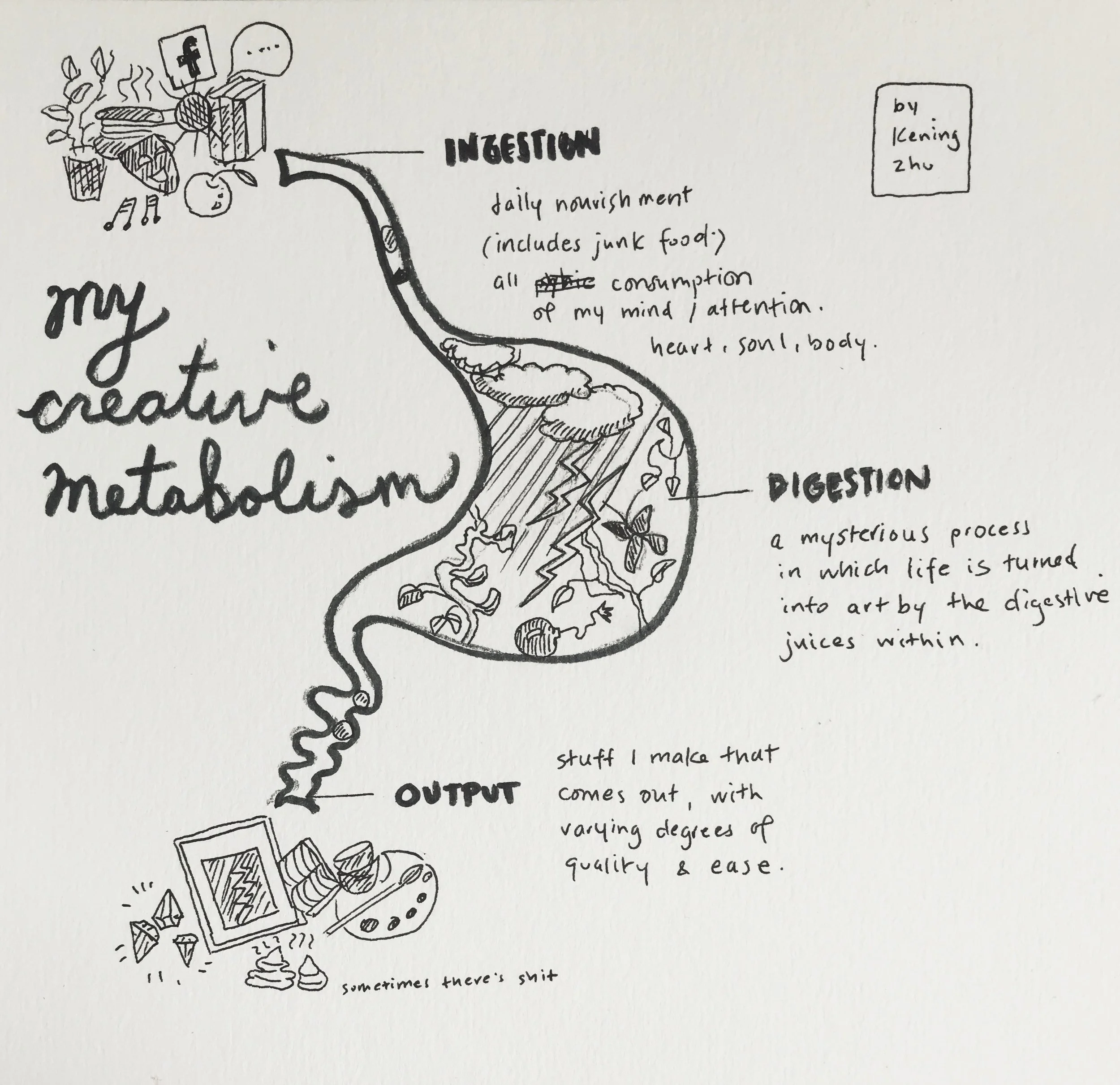how my creative metabolism works
Recently, as I've gained a better understanding of my physical metabolism, I've started to think about my creative metabolism -- how I ingest, digest, and create my art. (The term came from my dear college professor Margo, who said something to me, six years ago, about paying more attention to my psychic metabolism.) Yesterday, after weeks of feeling creatively blocked and sluggish, I sat down with a prolific artist friend, Brian Foo, on the crowded lawns of Washington Square Park, and - against wafts of weed and very loud drumming music - came up with this theory.
Theory of my creative metabolism:
I have a fast, active creative metabolism that needs consistent nourishment, a sense of spaciousness for digestion, and impulsive daily release - or it will get super constipated.
Does it make sense? Let me explain.
What works and what doesn't
All these years I've been trying to build more structure, routine, and discipline into my daily creative processes, treating myself, at times, like a boot camp marathon trainee. So I commit to a lot of ambitious, long term creative projects and then I get bored, restless, and regretful that I chained myself in. I might have spongey, fertile ideas, but if I let them sit in my head for too many days, they grow stale, and then become mental blockage -- a guilty reminder of what I didn't do.
Recently, I noticed that what works best for me is following my creative impulses for that day, instead of what I feel obligated (by my rational mind, my to-do lists) to do. Obviously this will always be a dance of balance. But being spontaneous, listening to my inspiration, and carving out intense, focused blocks of time is the best way for me to keep making a steady flow of work. It is consistency, but in spurts. A marathon made up of short sprints -- only in retrospect can I thread everything together.
Inspiration like chasing a storm
When I think about what inspiration feels like for me, I think of a story that Elizabeth Gilbert spoke about in her TED talk. I relate to this feeling completely.
"I met the extraordinary American poet Ruth Stone, who's now in her 90s. She's been a poet her entire life. She told me that when she was growing up in rural Virginia, she would be out working in the fields, and she would feel and hear a poem coming at her from over the landscape. She said it was like a thunderous train of air, coming barreling down at her over the landscape, and she'd feel it coming, because it would shake the earth under her feet. She knew that she had only one thing to do at that point, and that was to, in her words, 'run like hell.' And then she would run like hell to the house, chased by this poem; she had to get to a piece of paper and a pencil fast enough so that when it thundered through her, she could collect it, and grab it on the page. Other times she wouldn't be fast enough, so she'd be running and running but she wouldn't get to the house, and the poem would barrel through her and she would miss it. It would continue on across the landscape, looking, as she put it 'for another poet.'
The difference for me, though, is that if I don't catch the poem, it'll come back to haunt me. In the form of constipation.
But of course! This is how I write my best prose pieces (in three days), do my favorite paintings (in three hours), launch my favorite projects (in one day). This is how I like to dance tango (for twenty hours over three days). This is even how I like to do a relationship (two intense days together, three days not speaking, not even texting). But I was resisting my own process because it felt too haphazard, dependent on my changing moods and whims, too unpredictable. It's not slow-and-steady, it's not what I've been conditioned to believe is "best." But oh, to hell with conditioning! I'm also realizing that there is some measure of predictability within the "chaos."
Here's some personal notes on my creative gut health. Did I inspire you to get to know your creative digestive processes? Please do share!
Kening's creative digestive summary
Best nourishment: routine self care, solitude, creative friends, wild emotions, arthouse films, books, culture, poetry, solo travel, spontaneous conversations with strangers
Junk food - mindless use of social media, crowds, shallow conversations with large groups of people
Best digestion methods: afternoons and late mornings, during liminal spaces like transits, spaciousness for solitude and doing nothing; daydreaming time
Necessary tools for digestion: a notebook and a pen
Best laxatives: a creative friend, a creative cleanse, a time-bound deadline, monetary awards, vigorous exercise.
Best conditions for output: ASAP after digestion, best in the mornings (before noon) and late evenings (after 7pm).
Ideal length of output: 1-3 days is ideal. one week is okay. projects longer than six weeks are run higher risk of constipation.
How to optimize output: be very sensitive to creative urges and digestion occurring. Find bathrooms ASAP.
*
more on creative practices

